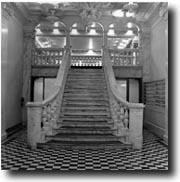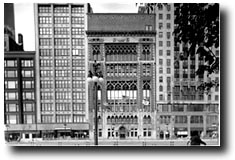 |
By Mary Ruth
Yoe
Photography
by Patricia Evans
Sitting in his law office on the 80th floor of the Sears Tower—the
most recognizable building in the city of Chicago’s skyline—Julius
Lewis, AB’50, AM’54, talks with affection about landmark
buildings of another sort and another era: the elegant architecture
of Henry Ives Cobb.
|

Cobb’s design for the interior
of the Chicago Athletic Association leaves no doubt, says
Julius Lewis, that “this is a building built for pleasure.”
Continuing the elaborate nature of the exterior, the interior
is a collection of fancifully ornamental wood, marble, and
mosaics—including the wedding cake of a marble staircase
leading to the mezzanine and the association’s swimming
pool.
|
“Cobb was a great deal more important in his time than the
little published material about him would suggest,” says Lewis,
an attorney with Sonnenschein, Nath, and Rosenthal. In the post–Chicago
Fire building boom of the 1880s and early 1890s, Cobb—working
first with Charles Sumner Frost and then with his own firm—garnered
some of the city’s most prominent commissions. The castle built
for Potter Palmer, owner of the Palmer House Hotel. The Newberry
Library. The Fisheries Building at the 1893 World’s Columbian
Exposition.
Best known to University of Chicago alumni as the creator of the
central quadrangles, Henry Ives Cobb designed 18 of the campus’s
structures—from the institution’s very first building,
Cobb Lecture Hall (1892), through the eponymous Cobb Gate in 1900.
The list goes almost literally from A to Z and includes (in order
of construction) Blake, Gates, Goodspeed, Beecher, Kelly, Foster,
Snell, Walker, Kent, Ryerson, the President’s House, Haskell,
Green, and the Anatomy, Botany, Physiology, and Zoology Buildings.
|

From its facade, one might expect
the Chicago Athletic Association building (1893) at 12 South
Michigan Avenue to be overlooking a Venetian canal. “Designed
for a client who was willing to spend money on an elaborate,
showy building,” says Lewis, the structure offers more
than a suggestion of a 14th-century palazzo, though Cobb used
the 1-3-1 organization of the building’s “bays”
for ornamentation, not function.
|
Cobb had earned a national reputation as the 19th century drew
to a close, designing major buildings in cities throughout the Midwest
and on the East Coast. Still, his reputation eventually fell victim
to the fact that he was no Henry Hobson Richardson, no Louis Henry
Sullivan, no Frank Lloyd Wright—the three American architectural
geniuses whom, Julius Lewis says with a touch of asperity, “modern
criticism emphasized in a trinity that left out everyone else.”
Continued...
|



